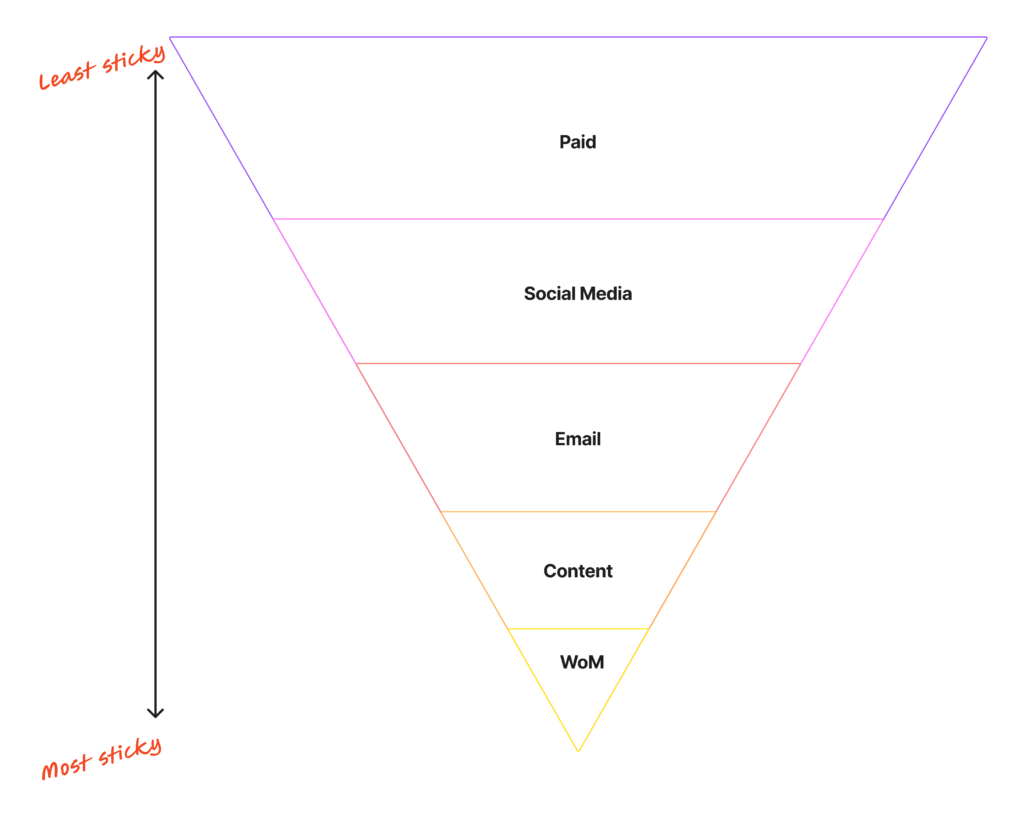Sales can be an addictive drug. For new companies, it’s the toll you have to pass to prove product market fit. Mature companies need sales to prove their relevance and appease shareholders. Realistically, you don’t have a business without sales. However, if you’re not focusing on customer stickiness then sales metrics are pure vanity.
Customer stickiness tries to measure how likely a customer is to continue purchasing your product or service. It’s a transactional metric and not to be confused with customer loyalty. Customer stickiness is a building block for loyalty and retention. More importantly, repeat customers spend an average of 67% more than new customers.

I made this simple graph to illustrate marketing strategies with the best chance of acquiring sticky customers. Remember, these are generalizations. For instance, paid or performance media can absolutely bring in sticky customers. But, the stats don’t lie.
People are 90% more likely to trust and buy from a brand recommended by a friend. Word-of-mouth marketing results in five times more sales than paid ads. Lastly, customers acquired through word of mouth promotion spend 200% more than the average customer. Get my drift?
Focusing on customer stickiness is a great way to ensure your business is providing value. Consider many of the tactics that help increase stickiness:
- Offer high-touch onboarding
- Provide repeated value
- Conduct user research
- Send personalized email content
- Consistently provide great brand experiences
Many of these tactics force you to audit the customer experience more intentionally. Therefore, you’ll find ways to improve both experience and offering. There’s more! Every acquisition channel has a price tag, organic or not. The most expensive channel is paid media, and it has the lowest probability of increasing customer stickiness. Anecdotally, I think it has the highest potential earlier on. More on that another time.
The other benefit of increasing stickiness is decreasing customer acquisition costs, or CAC. When you create repeat customers, you are generating future sales. You’re also increasing the likelihood that your sticky customers will refer their friends and family. Referrals are cheaper than paying Mark Zuckerberg to source your next buyer.
Customer Acquisition Costs
The amount of money a business spends to get a customer to purchase its products or services. Successful business models have a sufficiently lower CAC than LTV. However, it’s likely to take time to achieve a healthy CAC:LTV ratio. A simple equation for customer acquisition costs:
CAC = (total cost of sales and marketing) / (# of customers acquired)
Customer stickiness is a no-brainer. However, that doesn’t mean it’s easy to engineer. It’s great because it’s a win-win. Your business should be relentless about providing value and optimizing for happy customers. The more well-oiled the machine, the less it will cost to find and retain new customers. Unfortunately, everything costs money. On the bright side, smart strategies that increase stickiness, loyalty and retention help reduce CAC and increase LTV (lifetime value).
